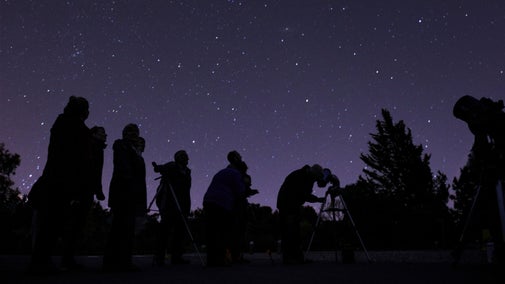
‘50 things to do before you're 11¾’
Have fun exploring nature and the great outdoors with our list of ‘50 things to do before you're 11¾’.

Some creatures only come out at night, so this is your only chance of spotting or hearing them. We've got some tips to help you get the most out of no. 40 of our ‘50 things to do before you’re 11¾’, go on a nature walk at night.
Going on a nature walk at night means you'll see and hear lots of things that you wouldn't normally notice in the daylight.
Here's a quick list of what you'll need if you're planning your night time walk.
Depending on the time of year you do your nature walk, you'll have a very different experience.
In the summer, keep a look out for moths and bats darting about overhead. Bats fly in loops and are brilliant to watch in low light.
The light nights of summer mean that you'll have to wait until a lot later for it to get dark, but dusk is often a great time for a walk, as although the animals who are active in the daytime are going to sleep, it's also the time that nocturnal animals such as hedgehogs and foxes are waking up and coming out.
You might see and hear crickets, foxes, tawny, short-eared, barn or little owls, rabbits and hedgehogs. If you live in southern England, you might even hear a nightingale during the summer months as they visit the UK at this time of year.
As the nights turn darker and a little bit chillier, and the leaves begin to change colours and fall to the ground, autumn gives you a different world for a night time walk.
Rustling in fallen leaves could be hedgehogs, or snails working their way through the decaying matter.
Deer are often grazing at dusk in the autumn, so you stand a good chance of seeing them if you live near fields, forests or parkland.
Redwings, fieldfares, song thrushes and blackbirds come from Scandinavia and Iceland to feed on autumn berries, and often travel at night, so with good eyes you might well be able to pick some out on your walk.

As the nights get dark earlier, it's easier to fit in a walk before dinnertime. It might be colder going for a nature walk at night in winter, so you might need to wear warmer clothes and not stay outside as long.
Things you're likely to spot on a winter night include foxes, owls and possibly hedgehogs looking for food. If it has been snowing, you can sometimes see tracks in the snow which will give you an idea what you might see on your walk.
With winter on the way out and everything growing again, spring is all about new life outside.
If you live in the countryside, you'll hear baby lambs bleating, you might see pheasants in the dusk and bats start to emerge from hibernation. Even in cities, you should still be able to hear the signs of new life, like chicks tweeting.
Spring is also a good time for spotting baby badgers leaving their setts, if you're quiet enough so they don't hear you – badgers have great ears.
If you're going beyond your garden, take a grown up and a charged mobile phone for emergencies.

Have fun exploring nature and the great outdoors with our list of ‘50 things to do before you're 11¾’.

To ensure you can complete your ‘50 things to do before you’re 11¾’ activities safely, here are some top tips to help you complete your challenges with safety in mind.

Stargazing is a magical way to bring nature to life. We have tips on the constellations to spot and the stories behind them. Going stargazing is one of our list of ‘50 things to do before you’re 11¾’.

You can double the fun when you share your wildlife adventures with a friend. Taking a friend on a nature adventure is no. 50 on our list of ‘50 things to do before you’re 11¾’.